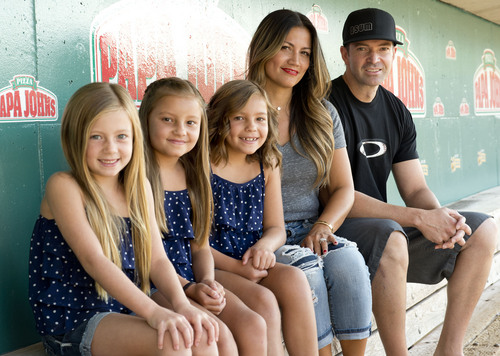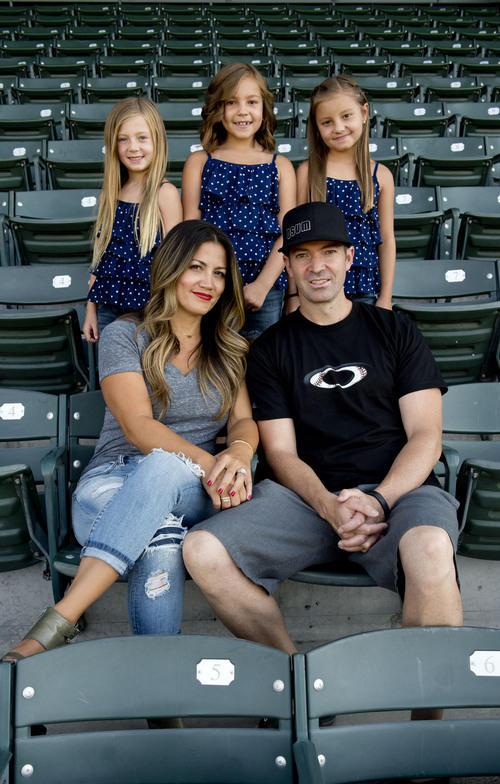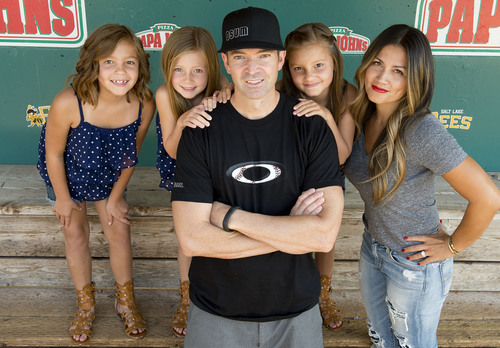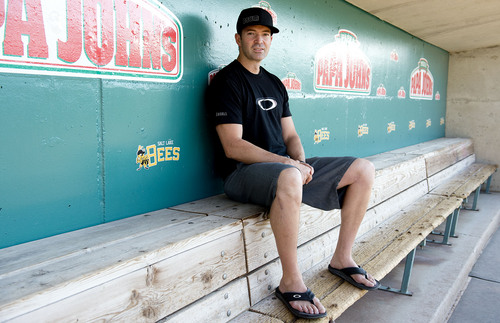This is an archived article that was published on sltrib.com in 2014, and information in the article may be outdated. It is provided only for personal research purposes and may not be reprinted.
The Salt Lake Bees took the field, wearing the uniform he once modeled. With an arm around his daughter's chair, Zach Sorensen pointed to the various positions he played at Smith's Ballpark.
Moments later, he was just another helpful fan. "This is Section 20," he explained to a woman, searching for her seat.
"Oh, Section 20?"
Sorensen glanced at her ticket: Section 21, Row 6. "I think it's right over there, down on this row."
Sorensen laughed. This is his life in baseball, nine years after his last appearance in the major leagues with the Los Angles Angels, the Bees' parent club. He brought his family from the St. George area for a Fourth of July vacation that included a ballpark visit, even though sitting in the stands is hardly easy for him.
"Most of the time, you wish you were still playing," Sorensen said. "I don't share that with too many people, but of course, you'd love to be out there."
Sorensen played 173 games for Salt Lake's Triple-A team, batting over .300, in 2004-05. His big-league appearances with Cleveland and the Angels combined for nearly one year of service as a utility player.
His biggest moment came during the Angels' 2005 run to the AL West championship. Joe Maddon, then an Angels coach, claimed credit for getting him in the lineup that night in Chicago. Maddon said he persuaded manager Mike Scioscia to play Sorensen at second base because he'd "dominated" White Sox pitcher Mark Buehrle, having gone 1-for-3 against him in '03 with Cleveland.
"Don't let me down," Maddon said.
Sorensen doubled against Buehrle, who's a 2014 All-Star for Toronto, and went 2 for 4 in a 12-inning victory over the eventual World Series winners.
He played in Triple-A for two other organizations before retiring in 2007 at age 30, recognizing the odds against returning to the majors — where his lifetime batting average is .143, with seven hits in 49 at-bats.
Whenever well-meaning people asked why he didn't last longer among those big-leaguers, Sorensen would say wryly, "They're pretty good."
Yet he got there from the Foothill Little League, via Highland High School, and he'll never deflate anyone's dream. When he talks to young players, "Instead of saying your chances of making it are slim," he said, "I'll spin it on 'em and say, 'You never know.' "
His wife, Shally, joined him in the journey through the minor leagues, including those April nights at the ballpark in Buffalo, where she zipped herself into a sleeping bag. "I felt every emotion that he did," she said. "There are not many careers where a wife can be so involved. His dream became my dream. We grew closer in a unique way. … Baseball was our life — and I wouldn't have it any other way."
A father of four, Sorensen can define his career by parental checkpoints. During his season in Cleveland, he joined his son, Jaxon, in a pregame walk between first and second base. The moment was later captured in a painting.
In 2005, with the Angels having clinched the division title and Scioscia resting some regulars, Sorensen's playing opportunity coincided with the birth of his twin daughters, Braylen and Serae. So he played in Oakland on Thursday, came home for two days and rejoined the team in Texas for the final game. He stayed with the Angels through the AL Championship Series, although he was not activated.
When then-Salt Lake owner Larry H. Miller adopted the Bees' name in 2005, Sorensen modeled the new uniform at a news conference. The Angels released him, though, and he signed with Milwaukee (and, later, Florida).
In April 2007, with Shally expecting another daughter, "I knew it was time to come home and be a dad," Sorensen said. He walked away from baseball as an Albuquerque Isotope.
Sorensen found himself in a transitional stage that George Theodore understands. "It's kind of a shock once you spend your life in sports and all of a sudden, it's not there," said the former New York Mets outfielder.
Theodore is a post-baseball success story. He earned a master's degree in social work at the University of Utah and has spent 36 years as an elementary school counselor in Granite School District. "I found I loved it," he said. "Working with the children, I found my niche."
Sorensen's next move was into an operating room. He took a job with Desert Orthopedics, a St. George-based company launched by Randy Wilstead, a friend and former pro baseball player. Sorensen assists surgeons, providing instruments and implants during long days in the OR.
His body clock — and his wife's — remain tuned to a baseball calendar, with spring training and the playoffs.
"Every February and every October, we get this ache," Shally Sorensen said, walking across the Smith's Ballpark outfield after a family photo shoot. "We do miss it in a lot of ways, for sure."
Twitter: @tribkurt —
One Year in the Big Leagues: About the series
What if you could play one year at the highest level of a sport? How would you view that experience and how would you spend the rest of your life? Utah high school graduates Fui Vakapuna, Brad Sutterfield, Zach Sorensen and Britton Johnsen each realized a lifelong dream, and then his opportunity was gone. These are their stories.
Today » Zach Sorensen —
Zach Sorensen file
Age • 37.
High school • Highland.
College • Wichita State.
Family • Wife, Shally; son, Jaxon (12); daughters Braylen (8), Serae (8) and Cambry (7).
Major league experience • Cleveland, 36 games played (2003); Los Angeles Angels, 12 games played (2005).
Job • Medical supplier, Desert Orthopedics, St. George.
Notable • Sorensen was among eight Salt Lake Valley high school graduates who appeared in the major leagues in 2005, joining Taylorsville's John Buck (Kansas City), Taylorsville's Brandon Lyon (Arizona), Kearns' Brandon Duckworth (Houston), Cyprus' Scott Eyre (San Francisco), East's Mike Gosling (Arizona), Cottonwood's Ryan Jensen (Kansas City) and Cottonwood's Chris Shelton (Detroit).











